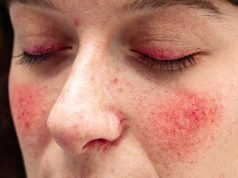Use of multiple sources with ALA-PDT doesn’t lead to significant improvement in patient outcome
MONDAY, July 18, 2016 (HealthDay News) — Use of multiple, sequential light and laser sources to activate aminolevulinic acid (ALA) in photodynamic therapy (PDT) does not lead to statistically significant improvements in patient outcome for rosacea, according to a study published online July 4 in the Journal of Cosmetic Dermatology.
Daniel P. Friedmann, M.D., from Westlake Dermatology & Cosmetic Surgery in Austin, Texas, and colleagues examined ALA-PDT for rosacea using blue light sequentially with red light, pulsed-dye laser (PDL), and/or intense pulsed light (IPL) in a retrospective study involving 39 patients. Treatment groups were: blue light + PDL; blue light + IPL; blue light + PDL + IPL; and blue light + red light + PDL + IPL. A telephone questionnaire was used to obtain patient-reported outcome measures.
The researchers found that patient-reported rosacea and overall skin quality improvement were not significantly different between the groups. The only significant difference in post-procedure adverse events was decreased peeling following blue light + IPL compared with blue light + PDL (P = 0.041) and blue light + IPL + PDL (P = 0.005).
“The use of multiple, sequential light and laser sources with ALA-PDT for rosacea, while well tolerated, did not lead to statistically significant improvements in patient-reported efficacy,” the authors write.
Copyright © 2016 HealthDay. All rights reserved.








